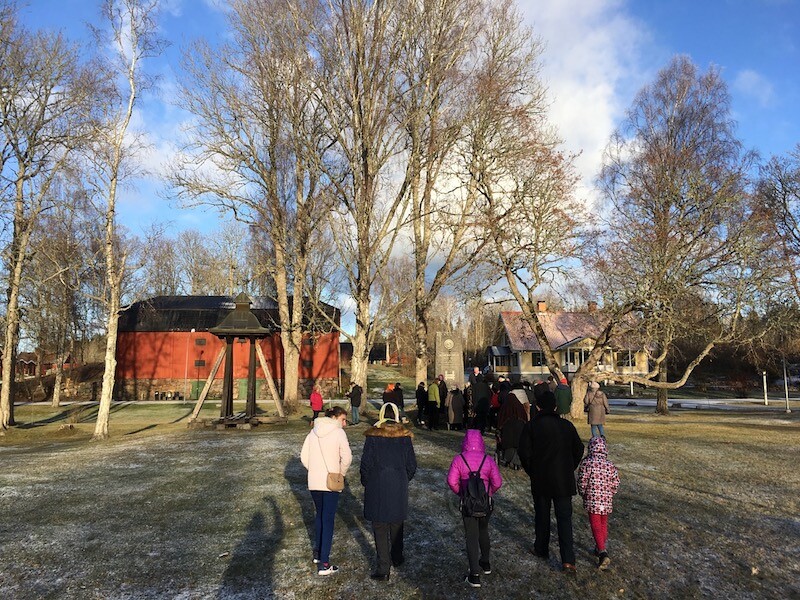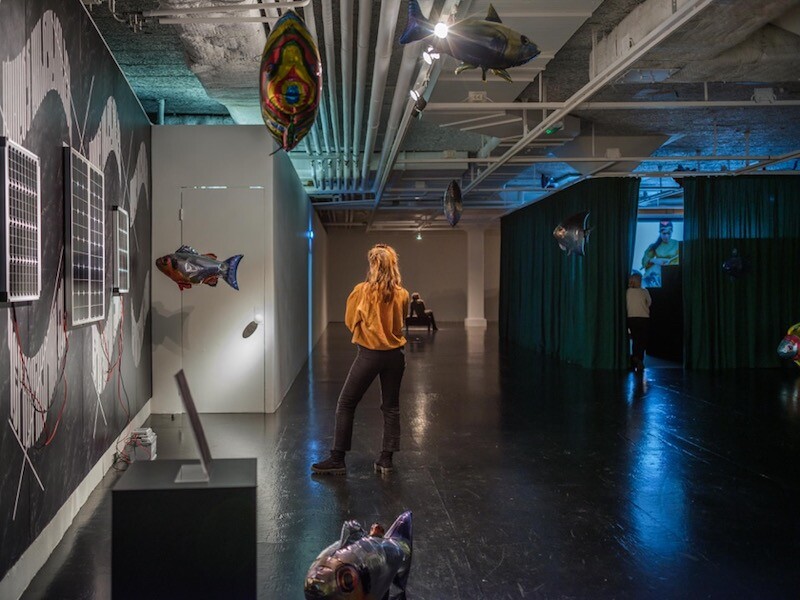On a late November Saturday morning in Tensta, a suburb 10 miles northwest of downtown Stockholm, a double-decker bus idled in the plaza of a shopping mall. People stood around drinking coffee and chatting. A woman wearing glasses and a hijab informed them in Arabic to board because the bus would soon depart. Her name is Fahyma Alnablsi. Originally from Damascus, she is 68 years old and has lived in Tensta for 25 years. While her official duties at Tensta konsthall include administration and education, Alnablsi is by all accounts a social conduit between the arts institution and community of Tensta. Built between 1967 and 1972 to provide homes to young families, today people from Afghanistan, Ethiopia, Iraq, Iran, Jordan, Kurdistan, Somalia, Syria, and Turkey live in the suburb. Alnablsi, trained as an educator, previously worked with some of these communities by volunteering at women’s organizations, teaching Swedish language classes, and advising on maneuvering government bureaucracy. In 2012, she was hired by the curator Maria Lind, who in December 2018 finished an eight-year tenure leading the institution. I visited Stockholm to conduct research for a new book that will study in part how modest-scaled institutions in Western cities connect to their audiences, especially local immigrant communities. This is a report from Tensta.
Lind, Alnablsi, and the konsthall’s team organized the bus tour destined two hours north to Folkets Hus, or People’s House, in Hallstavik. The highlight was the premiere of Sometimes It Was Beautiful (2018), a 38-minute film by Rwandan-born, Dutch artist Christian Nyampeta, currently based in New York. Commissioned by Lind and produced in collaboration with Stockholm’s Museum of Ethnography, the film is a reflection on In the Footsteps of the Witch Doctor (I fetischmannens spår) (1948), the first of several ethnographic films about the Congo by Swedish cinematographer Sven Nykvist (1922–2006). Sometimes It Was Beautiful was shot on location around Hallstavik, bringing together an anachronistic crew of characters, from Yasser Arafat and Winnie Mandela, to Andrei Tarkovsky and the Crown Princess Victoria of Sweden into a fictional filmic space. The unlikely group, played by an equally diverse group of Nyampeta’s friends, community members, and the konsthall’s team, formed an affective cast addressing the slow violence effected by the pursuit of knowledge, the conservation of heritage, and the imposition of culture.
The day’s itinerary served as a microcosm of the intense consideration Lind and her team give to commissions, exhibitions, and programing. The trip to Hallstavik included stops at other heritage sites, such as Skebo Bruk, a former ironworks factory that now houses refugees from Syria. The subtle but overlapping connections among place, labor, history, migration, and people in Sweden were relevant to themes addressed in Nyampeta’s film. This is how it works: Lind presents challenging, sophisticated art, mediated generously. She identifies the granular ways art, culture, and history can connect to audiences and intentionally provides institutional frameworks where people of varying ages, backgrounds, and knowledge intersect with the konsthall’s programs. The open approach to running the konsthall is part of what she calls “the generous edge.” This model is the opposite of dumbing down, of second-guessing what other people might want to see, allowing them to experience art on their own terms.
Located beneath the Tensta Shopping Mall, since its founding in 1998 the institution’s mission has always been to be conversant in international contemporary art while responsive to public life in Tensta. Lind became director on January 1, 2011. Aware of the local inhabitants’ wide-ranging experiences with art and cultural perspectives, her curatorial model relies on ambassador-like figures. These ambassadors often act as vanguards, connecting the institution to the social interstices that Lind values but perhaps doesn’t have knowledge or bandwidth to steward. Her ambassadors often have autonomy to initiate something related to their interests and knowledge within the wide institutional framework Lind offers. Fahyma Alnablsi is one such ambassador. Alnablsi informed me in an interview that 43 of the 65 people on the bus were from the Language Café and the Women’s Café, two important components of the konsthall’s program, herself spearheading the former. The Language Café is a continuation of Alnablsi’s work teaching Swedish before coming to Tensta konsthall; her weekly classes at the konsthall are now a part of The Silent University (2012–), artist Ahmet Ögüt’s ongoing project which brings together a peripatetic network of teachers, researchers, and fellows who participate in education models supporting refugees. The Women’s Café allows women to come together safely to make textile handicrafts, their gatherings also providing a space to talk about navigating daily life in a foreign country.
Tensta konsthall balances its engagement with art and ideas specific to a region by exhibiting artists more widely known in the global contemporary art scene. This balance ensures the institution’s relevance to a nearby constituency in dialogue with broader issues in contemporary art and culture. To that end, Philippe Parreno’s exhibition “My Room is Another Fish Bowl” was the final show of 2018. Dozens of colorful, shiny helium balloons of tropical and other fish hovered throughout the galleries, greeting visitors upon entering the konsthall. What do the playful forms mean? What does it matter? Tensta konsthall is a place where many things transpire at once. In my time there, I experienced people, food, films, artworks, books, and ideas coalescing beautifully inside the institution. Art is something that can be meaningful to non-art audiences, who engage with it in different ways. At Tensta, a combination of groups and individuals from different spheres of art and culture flow through this institutional framework, occasionally intersecting or just temporarily running alongside each other, enacting what Lind calls “the proximity principle.” Parreno’s fish move along wherever the airstream takes them. It is a fitting closure to Lind’s rich tenure, to her thoughtfully choreographed institution where generosity and hospitality reign supreme with precision and rigor, all operating under the auspices of contemporary art showing the many ways people can know and experience art, life, and much more. This is the generous edge.










